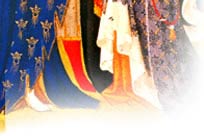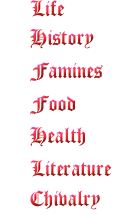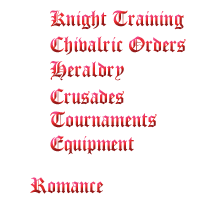 |
|||
  

|
Medieval Chivalry Chivalry is the generic term for the knightly system of the Middle Ages and for virtues and qualities it inspired in its followers. The word evolved from terms such as chevalier (French), caballero (Spanish), and cavaliere (Italian), all meaning a warrior who fought on horseback. The term came to mean so much more during medieval times. Chivalric orders first appeared with military activities against non-Christian states. During the Middle Ages, Western Europe aggressively sought to expand its area of control. The first orders of chivalry were very similar to the monastic orders of the era. Both sought the sanctification of their members through combat against "infidels" and protection of religious pilgrims, and both had commitments that involved the taking of vows and submitting to a regulation of activities. 13th Century conventions of chivalry directed that men should honor, serve, and do nothing to displease ladies and maidens. Knights were members of the noble class socially as bearers of arms, economically as owners of horse and armor, and officially through religious-oriented ceremony. While some were knighted on the battlefield, most spent long years as a squire, practicing the art of war while serving his master. People during the Middle Ages heard of the exploits of knights both mythical and real in epics like La Chanson de Roland and Le Morte D'Arthur. After the Crusades, knights continued to show their prowess and skills in medieval tournaments. |
 |
|
 |
|||
 |
|||